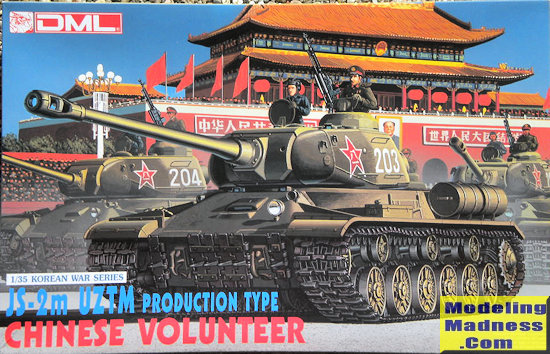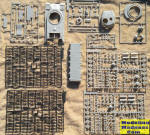
DML 1/35 JS-2m UZM Production Chinese Volunteer Heavy Tank
|
KIT #: |
6804 |
|
PRICE: |
$30.00 at LHS |
|
DECALS: |
Five options |
|
REVIEWER: |
|
|
NOTES: |
316 parts on 8 sprues |

The IS tank family (IS meaning the Joseph Stalin or Iosif Stalin) was a series of heavy tanks developed as a successor to the KV-series by the Soviet Union during World War II. The heavy tank was designed with thick armor to counter the German 88-mm guns and carried a main gun that was capable of defeating the German Tiger and Panther tanks. The IS-2 tank was popularly called the “victory tank” in the Soviet Union due to its close association with the defeat of Germany in 1945.
The KV-1 tank was criticized by its crews for its poor mobility and lack of any heavier armament than the T-34 medium tank. It was much more expensive than the T-34, without having greater combat performance. This led Moscow to order a portion of KV-1 assembly lines to shift to T-34 production, which fed into fears that KV-1 production would be halted and the SKB-2 design bureau led by General Zh. Kotin closed. In 1942 this problem was partially addressed by the lighter, faster KV-1S tank. However, the capture of a German Tiger tank in January 1943 led to a decision to develop a new heavy tank, codenamed izdeliye 237 (Item-237). While the izd.237 was still in development, another team under N. Dukhov was instructed to create a stopgap KV tank, the KV-85, which was armed with the 85-mm D-5T that proved capable of penetrating the Tiger I from 1000 meters. The KV-85 mounted the improved turet for the izd.237 on to the KV-1S, which required a fillet be added to the hull sides to provide the added space for the wider turret ring. Stalin authorized the immediate production of the KV-85 and instructed that the izd.237 be rushed into production as soon as possible as the IS-85 heavy tank.
Production efforts on the IS-85 began in September 1943 but, due to the new hull, improved suspension and the size of its armament, production was delayed. It was found during firing trials with the new D-5T 85-mm gun that the gun could not reliably penetrate the Tiger 1 except at ranges within the lethal range of the Tiger I’s own 88-mm gun. As a result, the decsion was made to adapt the A-19 122-mm corps gun to the same mounting used by the D-5T 85-mm gun because ammunition for the A-19 gun was already in the Red Army’s supply network. The new 122-mm tank gun was called the D-25T. This new design, the izd.240, was approved in November 1943 just as the first izd.237s were coming off the production lines. The izd.237s was accepted for service as the IS-85 with a total of 107 being completed by the beginning of 1944.
Production of the izd.240 was begun in January 1944, and the new design was called the IS-122. It was soon decided to simplify the designations for security purposes, with the izd.237 becoming the IS-1 and the izd.240 becoming the IS-2. Early IS-2s were characterized by a “stepped” front hull casting with a small, opening driver's visor. In addition, the early tanks did not have a gun tube travel lock or anti-aircraft machine gun and had a narrow gun mantlet. The demand for greater production of the IS-2 tanks led to a number of changes in the design. The front hull design, based on the KV-13 “universal tank” proved awkward to manufacture, so a new cast bow was develeoped in the spring of 1944 to remedy this. In addition, the mantlet and trunnion mounting for the D-25T gun, first developed for the smaller D-5T 85-mm gun, was not durable enough, resulting in a new, wider mantlet being introduced. Other changes included the substitution of the MK 4 periscope for the older PT-4-17 and the addtion of a 12.7-mm DShK heavy machine gun mounted on the commander’s cupola for vehicle defense. This improved version was called the IS-2m or IS-2 Model 1944. The IS-2 was used mainly to support breakthroughs at locations where German tank strength was especially weak, with the result that the IS-2 did not necessarily see a great deal of tank-versus-tank fighting. Their armor and firepower proved potent in intimidating the weakly supported German infantry. The IS-2’s main adversaries were German infantry anti-tank teams armed with panzerfaust and panzerschreck anti-tank rockets and the towed 75-mm PaK 40 anti-tank gun.
|
THE KIT |
 Upon opening the box, you’re presented
with six bags, each containing various sprues of parts for the tank. One bag
just contains the sprue for the DShK 12.7-mm
anti-aircraft machine gun,
and another contains the hull bottom. No figures are included with the kit. All
parts are molded in light gray and show very nice detail. Six of the parts are
marked not for use. There is very little flash,
although there are mold seams around the usual parts (wheels, etc.),
which will need to be scraped/sanded for a smooth finish. Ejector pin marks are
kept to the inside surfaces of the wheels,
so they will be pretty much out of view after assembly. The instructions
indicate a copyright year of 1995.
Upon opening the box, you’re presented
with six bags, each containing various sprues of parts for the tank. One bag
just contains the sprue for the DShK 12.7-mm
anti-aircraft machine gun,
and another contains the hull bottom. No figures are included with the kit. All
parts are molded in light gray and show very nice detail. Six of the parts are
marked not for use. There is very little flash,
although there are mold seams around the usual parts (wheels, etc.),
which will need to be scraped/sanded for a smooth finish. Ejector pin marks are
kept to the inside surfaces of the wheels,
so they will be pretty much out of view after assembly. The instructions
indicate a copyright year of 1995.
As the box indicates, the kit contains the later cast bow, wide type mantlet and turret featuring the MK 4 periscopes of the late JS-2 and JS-2m. The upper hull bow detail shows the bow with weld marks and made by the Ural Heavy Machine Tool Factory (UZTM) as shown in an illustration insert included with the kit. The rough cast texture on the turret, commander’s cupola, mantlet, muzzle brake and hull is restrained and well represented.
The rear exterior fuel drums common to the JS-2 tanks are included and are well made. The DShK anti-aircraft machine gun and the rear turret machine gun are molded solid, so they’ll need to be hollowed out (optional). The 122-mm main gun is in two halves. Both turret hatches can be positioned as opened since each contains interior detail. The kit features link and length tracks, so they will show the characteristic track sag along the return rollers when complete. There are also spare track links included to be attached to the hull. No clear parts are included.
The instructions are of the fold-out type and are well illustrated with exploded views showing a 13-step construction sequence with substeps included. There is a short history of the tank included. A diagram of each sprue with part numbers listed is shown, which is something that I always appreciate. The painting guide shows Gunze Sangyo colors. There is a black-and-white picture of a completed model in the instructions, and there are three color pictures of a completed model on the box, which will be useful for reference. The decals are glossy and thick with markings included for five vehicles, which include:
 People’s Liberation
Army , #203
People’s Liberation
Army , #203
85th Heavy Tank Regt., Red Army Berlin 1945, #414. These markings show white stripes around and on top of the turret, which will need to be painted on.
Polish People’s Army, Poland 1945, #055
Czechoslovak 1st Tank Bde., Prague 1945, #114
Chinese Volunteer Army Tank Regiment, North Korea 1952, #503
|
CONCLUSIONS |
This is a nice-looking kit that should look great when completed. I’m looking forward to building it!
|
REFERENCES |
IS-2 Heavy Tank 1944-1973 (New Vanguard) by Steven Zaloga, Osprey Publishing (1993)
Wikipedia—IS tank family: https://en.wikipedia.org/wiki/IS_tank_family
2016
Copyright ModelingMadness.com
Thanks to
If you would like your product reviewed fairly and fairly quickly, please contact the editor or see other details in the Note to Contributors.